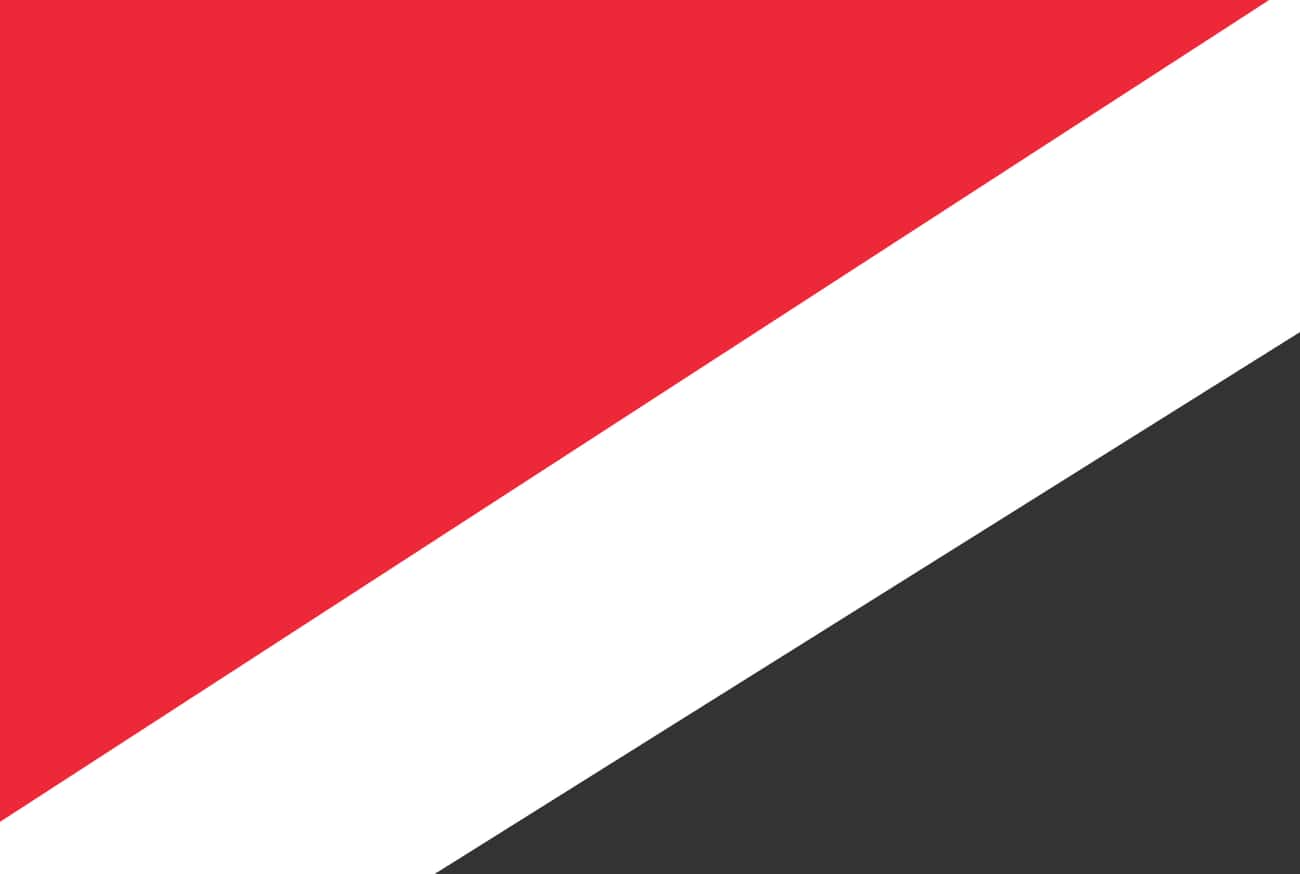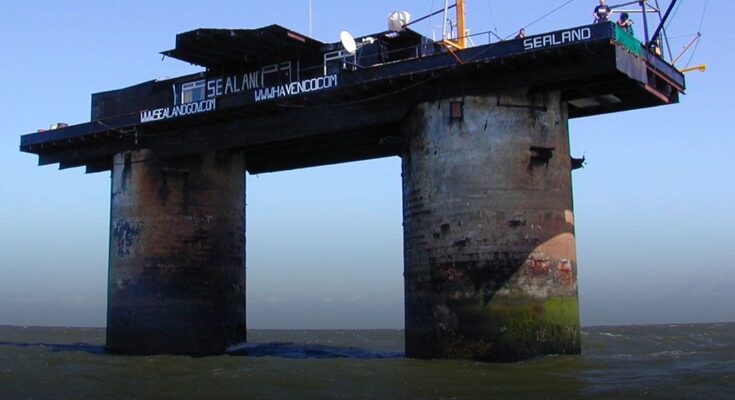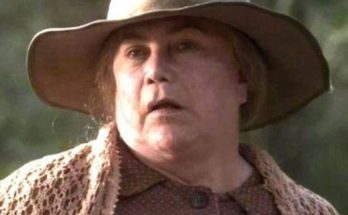You might think it’s impossible to have a country with a population of less than fifty people. Michael Bates, Prince Regent of the Principality of Sealand, disagrees.
What is Sealand? This micronation is housed on a decommissioned military fort, originally known as Rough’s Tower, located six miles off the coast of Suffolk, England. The fort was originally designed as an anti-aircraft defensive gun platform during World War II, but in 1967 it was taken over by Roy Bates and his family. Bates stole the platform from a group of pirate radio broadcasters, intending to set up his own pirate radio station. Instead, he set up a micronation and the Sealand government. His family continues to rule the platform in the manner of a royal family, passing titles from parents to children.
Although Sealand has its own flag, constitution, government, stamps, passports, and even soccer team, it isn’t officially recognized as a sovereign state by any country – not even England, where most of Sealand’s citizens actually reside. Life is tough when you’re an unrecognized micronation.
The U.K. Doesn’t Recognize Sealand As A Sovereign State

Photo: Zscout370 / Wikimedia Commons / Public Domain
When it was first established, Sealand wasn’t part of the United Kingdom. That changed in 1987, when the U.K. extended its territorial reach from three miles to twelve. Sealand, which sits six miles from British shores, was suddenly on British land.
Sealand doesn’t agree with this assessment. Michael Bates, the Prince of Sealand, told the BBC that Sealand “[has] never asked for recognition, and we’ve never felt the need to ask for recognition. You don’t have to have recognition to be a state, you just have to fulfill the criteria of the Montevideo Convention which is population, territory, government, and the capacity to enter into negotiation with other states.”
-
There Was An Attempted Coup
Photo: Feal / Wikimedia Commons / Public Domain
In August 1978, Prince Roy and his wife Princess Joan left Sealand on business. While they were gone, the self-described Prime Minister of Sealand, a German named Alexander Achenbach, hired a group of mercenaries to launch an attack on the micronation. After storming the platform, they took Prince Michael hostage. Prince Roy fought for his son’s release, and ended up holding Achenbach’s lawyer and charging him with treason.
The United Kingdom declined to intervene in the affair. Germany sent a diplomat over to negotiate, and they eventually convinced Sealand to release their citizen. Prince Roy considered the visit to be de facto recognition of Sealand’s sovereignty.
-
The Pirate Bay Tried To Buy Sealand
Photo: Onecanadasquarebishopsgatecommons / Wikimedia Commons / Public Domain
The Pirate Bay is an online hub for pirated movies, music, TV shows, and video games. Due to the highly illegal nature of the website, it has been trying to evade the law since its 2003 debut.
In 2007, Pirate Bay decided to outrun national copyright law by attempting to buy Sealand. The site began taking donations to meet the £504 million asking price, promising automatic Sealand citizenship in exchange. The Pirate Bay still does not own Sealand.
-
The Prince Of Sealand Got Away With Shooting At People
Photo: Richard Lazenby / Wikimedia Commons / Public Domain
In 1968, a group of engineers working on a nearby buoy hurled inappropriate sexual remarks at Penny Bates, the Princess of Sealand. Her brother Prince Michael overheard, and retaliated by firing at the engineers with an automatic pistol.
When the Prince traveled to mainland England, he was arrested and put on trial for a firearms offense. The case was thrown out of court because Sealand was beyond British jurisdiction, and the Prince got off scot-free. Prince Michael’s father, Sealand founder Roy Bates, called this decision confirmation of Sealand’s sovereignty.
-
The King Of Marduk Attempted To Claim Sealand
Photo: Tim Marchant / Wikimedia Commons / CC BY-SA 2.0
In 2009, a German man who called himself the King of Marduk attempted to claim Sealand for the so-called Kingdom of Marduk. He said that because Sealand wasn’t mentioned in any of the treaties created after World War II, it was up for grabs.
Prince Michael called the man an “imposter” and promised that “any persons attempting to encroach upon our territories without our permission will be dealt with appropriately.”
-
Most Sealand Citizens Don’t Live There
Photo: EL SARO 92 / Wikimedia Commons / Public Domain
Sealand has twenty two official residents, which isn’t exactly a thriving population. What’s more, many of them don’t actually live on Sealand full-time. When a reporter for the Belfast Telegraph visited in 2013, there were only five people present, and none of them lived there permanently.
Princess Penny couldn’t stand the place, and left for good as soon as she was able to. Prince Michael, whose family makes up most of the population, has been living in the U.K. for years. While he spent a large part of his own childhood on Sealand, he wanted his children to be educated in the U.K. Now that they are adults, his children help out with maintenance, and are expected to take full responsibility for Sealand.
In an interview with the BBC, Prince Michael said that, “with my new grandson Prince Freddy being fourth generation Sealander its future will be assured.”
-
Sealand Sells Titles To Support Itself
Photo: Dontkirk / Wikimedia Commons / CC BY 3.0
Have you ever wanted to become a count? What about a baroness, or a knight? If that sounds appealing, then head over to the online Sealand Shop, where you can buy these titles for prices ranging from £29.99 to £199.99.
Besides fancy titles, the Sealand Shop sells keychains, T-shirts, pens, mugs, and other swag. They also take donations. No one ever said running a micronation was cheap.
-
Thousands Requested Sealand Passports Post-Brexit And Trump
Photo: Alachua County / Flickr / CC BY 2.0
After Donald Trump was elected President of the United States, many Americans declared that they were leaving. A similar sentiment arose amongst British citizens who didn’t support Brexit.
Instead of looking into moving to Canada, thousands of people have applied for Sealand passports and residency. Sealand hasn’t issued any passports since September 11, but even if it did, the platform can only accommodate about 150 people.
-
Criminals Sold Fake Sealand Documents
Photo: Hideakioe / Wikimedia Commons / CC BY-SA 3.0
In 2000, Spanish police broke up an international crime syndicate that was selling fake Sealand passports, driver’s licenses, university titles, and nationality documents. These documents may have been used for money laundering and drug trafficking.
None of this made Sealand look particularly good, but there was no evidence of criminal involvement on their part.
-
FIFA Doesn’t Recognize Sealand’s Team
Photo: Public Domain / Wikimedia Commons / Public Domain
Sports can be a great way to stir up patriotism, so a micronation like Sealand starting its own football (or soccer) team makes a lot of sense. The Sealand National Football Association (SNFA) isn’t recognized by FIFA, but the team hopes to eventually compete in the VIVA World Cup, an international tournament for teams who aren’t part of FIFA.
-
It’s Nearly Impossible To Run A Tech Business There
Photo: Ryan Lackey / Wikimedia Commons / CC BY 2.0
In the early 2000s, Sealand was the proposed home of HavenCo, a tech venture that was intended to be a data safe haven for anyone who wanted to store data away from the prying eyes of governmental law. The servers would be stored in a nitrogen-based underwater environment that you’d need scuba gear to access, and armed guards would be on duty at all times. Ryan Lackey, a then 21-year-old MIT dropout who headed the project with the 32-year-old Sean Hastings, said that they would blow up the servers rather than let anyone access them.
The venture failed spectacularly. First of all, the dot-com bubble burst. But HavenCo also flopped due to its location. Sealand was too tiny to store much of anything, and due to the micronation’s offshore location, it cost a ton of money to bring and install supplies on the platform. The royal family also expressed concerns over antagonizing the British government by sanctioning potentially illegal activities.
-
Life On Sealand Can Be Really Boring
Photo: Ryan Lackey / Flickr / CC BY 2.0
There’s a reason why not even Prince Michael lives full time on Sealand: life there can be boring.
Sealand wasn’t equipped with electricity for years. While modern day Sealand does have electricity and Internet, there isn’t much else. With a nearly nonexistent population, there’s not much in the way of community life or activities.
It’s also cut off from the world. Prince Michael remembers how, during his teenage years, “you would go there and be there until the boat came back in two weeks to get you. And it might not come back for six weeks. You would stare at the horizon waiting for it to come back.”














